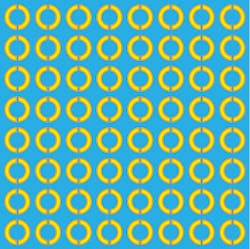Wako, Japan--Optical metamaterials, which enable perfect lenses and other unusual optics, are relatively easily made to work in the microwave region, where the metamaterials’ unit-cell size is on the order of millimeters; making metamaterials for use in the visible region is much tougher, as the unit-cell size is well under a micron.
Now, Takuo Tanaka from the Riken Metamaterials Laboratory, in collaboration with Shoichi Kubo and colleagues at Tohoku University, has demonstrated a scalable fabrication method that eases the production of metamaterials that can interact with light at visible wavelengths.1
Tanaka and his team created a silica-based metamaterial containing an array of split-ring resonators (gold rings with two small breaks at the top and bottom). A similar design has previously proved successful when used in the microwave region.
Metamaterials for use in the visible are commonly fabricated by electron-beam lithography, in which a beam of electrons draws each resonator one at a time. This process is painstakingly slow, particularly for the production of the millions of small features needed to create a visible-light metamaterial of a practical size.
Instead, the Riken researchers fabricated their structures through nanoimprint lithography, where a master mold of the desired design is transferred onto a thin polymer film; standard metallization techniques are then used to recreate the pattern in gold. In this way, the team was able to create split rings about 212 nm across and 54 nm high.
Tanaka and his colleagues demonstrated that their metamaterial magnetically interacts with red light. More important, however, is the scalability of their fabrication technique. Whereas techniques such as electron-beam lithography are limited to producing arrays of just several hundred square microns in area, Tanaka and his co-workers managed to create an array of 360 million split-ring resonators across a 5 mm square using their nanoimprint technique. “This is, to the best of our knowledge, the world’s largest two-dimensional split-ring resonator array metamaterial for visible light,” says Tanaka. “Our next step will be to create much larger metamaterials, to make them three dimensional, and to reduce the operation wavelength.”
Source: http://www.rikenresearch.riken.jp/eng/research/7493.html
REFERENCE:
1. Tomioka, T. et al., Applied Physics Letters 103, 071104 (2013).

